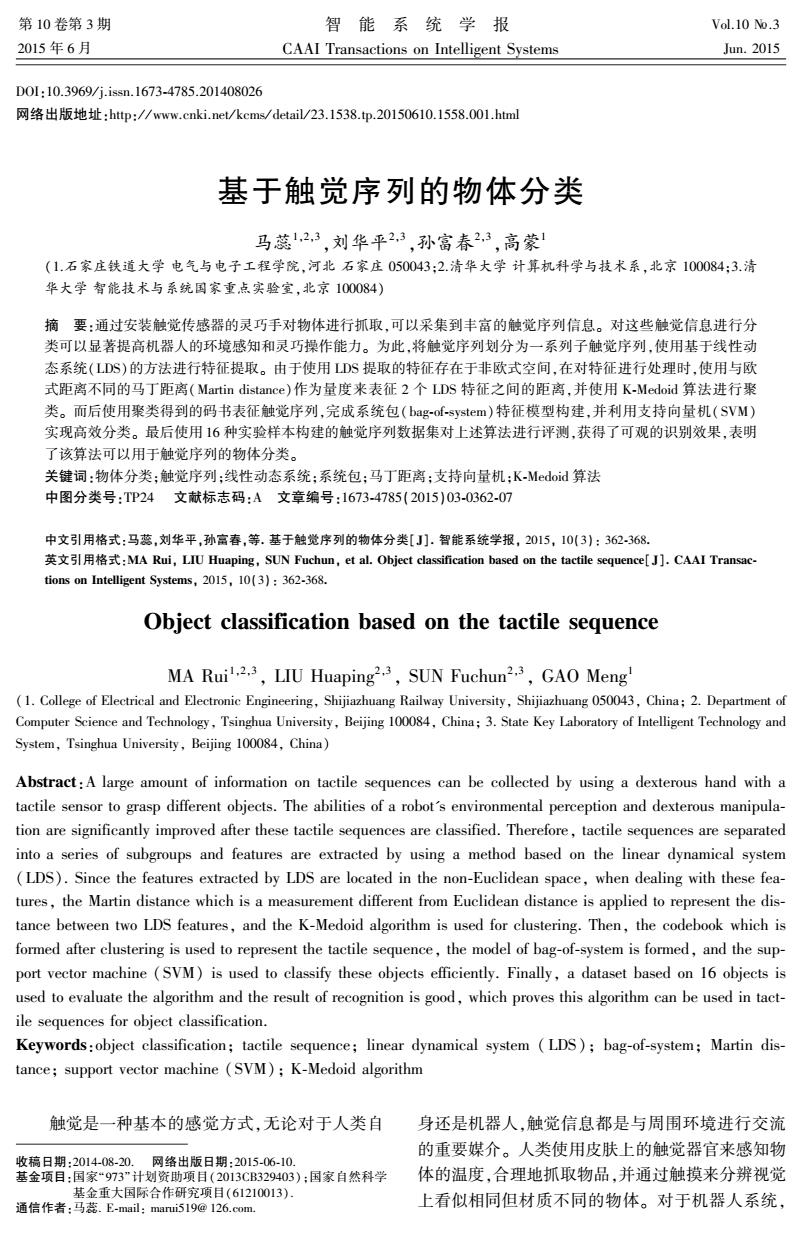正在加载图片...

第10卷第3期 智能系统学报 Vol.10 No.3 2015年6月 CAAI Transactions on Intelligent Systems Jun.2015 D0:10.3969/j.issn.1673-4785.201408026 网络出版地址:http://www.cnki.net/kcms/detail/23.1538.tp.20150610.1558.001.html 基于触觉序列的物体分类 马蕊123,刘华平23,孙富春23,高蒙 (1.石家庄铁道大学电气与电子工程学院,河北石家庄050043:2.清华大学计算机科学与技术系,北京100084:3.清 华大学智能技术与系统国家重点实验室,北京100084) 摘要:通过安装触觉传感器的灵巧手对物体进行抓取,可以采集到丰富的触觉序列信息。对这些触觉信息进行分 类可以显著提高机器人的环境感知和灵巧操作能力。为此,将触觉序列划分为一系列子触觉序列,使用基于线性动 态系统(LDS)的方法进行特征提取。由于使用LDS提取的特征存在于非欧式空间,在对特征进行处理时,使用与欧 式距离不同的马丁距离(Martin distance)作为量度来表征2个LDS特征之间的距离,并使用K-Medoid算法进行聚 类。而后使用聚类得到的码书表征触觉序列,完成系统包(bag-of-system)特征模型构建,并利用支持向量机(SVM) 实现高效分类。最后使用16种实验样本构建的触觉序列数据集对上述算法进行评测,获得了可观的识别效果,表明 了该算法可以用于触觉序列的物体分类。 关键词:物体分类;触觉序列;线性动态系统;系统包:马丁距离;支持向量机:K-Medoid算法 中图分类号:TP24文献标志码:A文章编号:1673-4785(2015)03-0362-07 中文引用格式:马蕊,刘华平,孙富春,等.基于触觉序列的物体分类[J].智能系统学报,2015,10(3):362-368. 英文引用格式:MA Rui,LIU Huaping,SUN Fuchun,etal.Object classification based on the tactile sequence[J].CAAI Transac- tions on Intelligent Systems,2015,10(3):362-368. Object classification based on the tactile sequence MA Rui2.3,LIU Huaping2.3,SUN Fuchun2.3,GAO Meng' (1.College of Electrical and Electronic Engineering,Shijiazhuang Railway University,Shijiazhuang 050043,China;2.Department of Computer Science and Technology,Tsinghua University,Beijing 100084.China;3.State Key Laboratory of Intelligent Technology and System,Tsinghua University,Beijing 100084,China) Abstract:A large amount of information on tactile sequences can be collected by using a dexterous hand with a tactile sensor to grasp different objects.The abilities of a robot's environmental perception and dexterous manipula- tion are significantly improved after these tactile sequences are classified.Therefore,tactile sequences are separated into a series of subgroups and features are extracted by using a method based on the linear dynamical system (LDS).Since the features extracted by LDS are located in the non-Euclidean space,when dealing with these fea- tures,the Martin distance which is a measurement different from Euclidean distance is applied to represent the dis- tance between two LDS features,and the K-Medoid algorithm is used for clustering.Then,the codebook which is formed after clustering is used to represent the tactile sequence,the model of bag-of-system is formed,and the sup- port vector machine (SVM)is used to classify these objects efficiently.Finally,a dataset based on 16 objects is used to evaluate the algorithm and the result of recognition is good,which proves this algorithm can be used in tact- ile sequences for object classification. Keywords:object classification;tactile sequence;linear dynamical system (LDS);bag-of-system;Martin dis- tance;support vector machine (SVM);K-Medoid algorithm 触觉是一种基本的感觉方式,无论对于人类自 身还是机器人,触觉信息都是与周围环境进行交流 的重要媒介。人类使用皮肤上的触觉器官来感知物 收稿日期:2014-08-20.网络出版日期:2015-06-10. 基金项目:国家“973”计划资助项目(2013CB329403):国家自然科学 体的温度,合理地抓取物品,并通过触摸来分辨视觉 基金重大国际合作研究项目(61210013). 通信作者:马蕊.E-mail:maui519@126.com. 上看似相同但材质不同的物体。对于机器人系统,第 10 卷第 3 期 智 能 系 统 学 报 Vol.10 №.3 2015 年 6 月 CAAI Transactions on Intelligent Systems Jun. 2015 DOI:10.3969 / j.issn.1673⁃4785.201408026 网络出版地址:http: / / www.cnki.net / kcms/ detail / 23.1538.tp.20150610.1558.001.html 基于触觉序列的物体分类 马蕊1,2,3 ,刘华平2,3 ,孙富春2,3 ,高蒙1 (1.石家庄铁道大学 电气与电子工程学院,河北 石家庄 050043;2.清华大学 计算机科学与技术系,北京 100084;3.清 华大学 智能技术与系统国家重点实验室,北京 100084) 摘 要:通过安装触觉传感器的灵巧手对物体进行抓取,可以采集到丰富的触觉序列信息。 对这些触觉信息进行分 类可以显著提高机器人的环境感知和灵巧操作能力。 为此,将触觉序列划分为一系列子触觉序列,使用基于线性动 态系统(LDS)的方法进行特征提取。 由于使用 LDS 提取的特征存在于非欧式空间,在对特征进行处理时,使用与欧 式距离不同的马丁距离(Martin distance)作为量度来表征 2 个 LDS 特征之间的距离,并使用 K⁃Medoid 算法进行聚 类。 而后使用聚类得到的码书表征触觉序列,完成系统包( bag⁃of⁃system)特征模型构建,并利用支持向量机( SVM) 实现高效分类。 最后使用 16 种实验样本构建的触觉序列数据集对上述算法进行评测,获得了可观的识别效果,表明 了该算法可以用于触觉序列的物体分类。 关键词:物体分类;触觉序列;线性动态系统;系统包;马丁距离;支持向量机;K⁃Medoid 算法 中图分类号:TP24 文献标志码:A 文章编号:1673⁃4785(2015)03⁃0362⁃07 中文引用格式:马蕊,刘华平,孙富春,等. 基于触觉序列的物体分类[J]. 智能系统学报, 2015, 10(3): 362⁃368. 英文引用格式:MA Rui, LIU Huaping, SUN Fuchun, et al. Object classification based on the tactile sequence[J]. CAAI Transac⁃ tions on Intelligent Systems, 2015, 10(3): 362⁃368. Object classification based on the tactile sequence MA Rui 1,2,3 , LIU Huaping 2,3 , SUN Fuchun 2,3 , GAO Meng 1 (1. College of Electrical and Electronic Engineering, Shijiazhuang Railway University, Shijiazhuang 050043, China; 2. Department of Computer Science and Technology, Tsinghua University, Beijing 100084, China; 3. State Key Laboratory of Intelligent Technology and System, Tsinghua University, Beijing 100084, China) Abstract:A large amount of information on tactile sequences can be collected by using a dexterous hand with a tactile sensor to grasp different objects. The abilities of a robot's environmental perception and dexterous manipula⁃ tion are significantly improved after these tactile sequences are classified. Therefore, tactile sequences are separated into a series of subgroups and features are extracted by using a method based on the linear dynamical system (LDS). Since the features extracted by LDS are located in the non⁃Euclidean space, when dealing with these fea⁃ tures, the Martin distance which is a measurement different from Euclidean distance is applied to represent the dis⁃ tance between two LDS features, and the K⁃Medoid algorithm is used for clustering. Then, the codebook which is formed after clustering is used to represent the tactile sequence, the model of bag⁃of⁃system is formed, and the sup⁃ port vector machine (SVM) is used to classify these objects efficiently. Finally, a dataset based on 16 objects is used to evaluate the algorithm and the result of recognition is good, which proves this algorithm can be used in tact⁃ ile sequences for object classification. Keywords:object classification; tactile sequence; linear dynamical system ( LDS); bag⁃of⁃system; Martin dis⁃ tance; support vector machine (SVM); K⁃Medoid algorithm 收稿日期:2014⁃08⁃20. 网络出版日期:2015⁃06⁃10. 基金项目:国家“973”计划资助项目(2013CB329403);国家自然科学 基金重大国际合作研究项目(61210013). 通信作者:马蕊. E⁃mail: marui519@ 126.com. 触觉是一种基本的感觉方式,无论对于人类自 身还是机器人,触觉信息都是与周围环境进行交流 的重要媒介。 人类使用皮肤上的触觉器官来感知物 体的温度,合理地抓取物品,并通过触摸来分辨视觉 上看似相同但材质不同的物体。 对于机器人系统